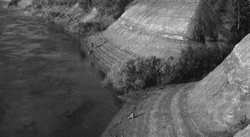
Fossil Reptiles on the Russian Platform
Originally published in Journal of Creation 15, no 1 (April 2001): 5-6.
Abstract
This fossil graveyard is consistent with the Biblical Flood and a contradiction to the slow-and-gradual uniformitarian doctrine.
Not long ago, Russian television reported an exciting find of large fossil tetrapods (pareiasaurs) in the Upper Permian strata of the western Russian platform.1 In that telecast, the director of the local paleontological museum described how the reptiles were buried in a standing position with their heads erect. This seemed so interesting and unusual that I visited the excavation site.

Photo by Kotelnich Paleontological Museum
Figure 1. The Kotelnich tetrapod locality. The steep western bank of the Vyatka River is primarily composed of continental redbeds consisting of clays, marls and sandstones. The annual spring floods wash out the bony remains.
The site is situated in the basin of the Vyatka River near Kotelnich (800 km north-east of Moscow). More than 300 tetrapod skeletons have been found in a steep bank, along a 3 km stretch of the river (Figure 1).
The Kotelnich paleontological museum tries to explain the unusual burial position in terms of the pareiasaurs being ‘bogged in soft sediment after heavy rainfall, when the water level was higher and boggy substratum became silty swamp’.2 The sedimentary conditions of the region are also interpreted in terms of uniformitarian geology. Coffa, from Monash University, Australia, described the strata in detail.3,4 He determined five horizons when deposition ceased and erosion surfaces developed in the sedimentary sequence (up to 50 m thick). According to their timescale, uniformitarians say the strata are 260 million years old.
To me these conclusions are very questionable:5
-
Pareiasaurs were herbivorous reptiles that lived in similar conditions to the modern giant aquatic turtle. I am not a reptile expert, but I have never heard of turtles being drowned in a swamp. It is more likely that the environmental conditions changed catastrophically and caught them unaware.
-
Uniformitarians estimate the average rate of deposition for the area is millimeters or centimeters per thousand years. For these pareiasaurs to be buried in this way in the sediment (Figure 2), they would have to remain standing with head erect for at least ten thousand years. This would have been difficult, even for such patient animals as pareiasaurs! It is clear that these strata were deposited much quicker than uniformitarians believe, and that the rate of sedimentation was much greater.
-
The silts and marls in which the pareiasaurs were buried contain virtually no plant fossils. It is difficult to imagine how 300 large reptiles, each more than 1 m long, could live without food on a piece of land just 3 km long. It is more likely that the reptiles migrated into the area to flee some catastrophic change in the environment, or that water currents carried them there.
-
 Figure 2. Position of the pareiasaur in the sediments.
Figure 2. Position of the pareiasaur in the sediments.The Upper Permian strata were deposited during the final marine transgression for the region. Since that time (allegedly 260 million years in the uniformitarian timescale) not more than 1020m of the land surface has been eroded. Based on average erosion rates for some of the major rivers of the world (0.2–1.4 mm per year6), the timing of the transgression fits better with the date of the Biblical Flood, about 4,500 years ago.
Conclusion
This new find of fossil tetrapods from the Russian platform, buried in standing position with head erect, indicates catastrophic sedimentation conditions. This fossil graveyard is consistent with the Biblical Flood and a contradiction to the slow-and-gradual uniformitarian doctrine.
References
- The Kotelnich Palaeontological Museum, 8 December 2000. See ‘Kotelnich district of the Kirov Region’ and ‘Kotelnich locality’ pages. Return to text.
- Ref. 1, see ‘Fossils’ page. Return to text.
- Coffa, A.A., Stratigraphy and correlation of the continental redbed sequence at the Kotelnich Upper Permian fossil tetrapod locality, Russia, Geological Society of Australia, Abstracts 46, pp. 1517, 1997. Return to text.
- Coffa A.A., Sedimentology and stratigraphy of the continental redbed sequence at the Kotelnich Late Permian fossil tetrapod locality, Russia, M.S. Thesis, Monash University, 1998. Return to text.
- These are only the preliminary results of the investigations made during my short trip to the site, which looks very promising for reconstruction of the sedimentation conditions. Investigators from Monash University, Australia, have made several visits to the area. I would be happy to talk to anyone interested in collaborative research in the area. Return to text.
- Walker, T., Eroding ages: if our continents were old, they would no longer be here, Creation 22(2):1821, 2000. Return to text.
Recommended Resources

Answers in Genesis is an apologetics ministry, dedicated to helping Christians defend their faith and proclaim the good news of Jesus Christ.
- Customer Service 800.778.3390
- © 2025 Answers in Genesis




